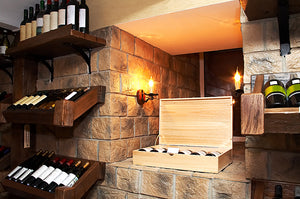I Heard It Through The Grapevine: Some Fun Facts About Wine!
Feb 10, 2024
Some claim that wine is the nectar of the Gods, and it certainly has a history that stretches back to those ancient and mythological times. It’s a fascinating drink that some people devote their lifetime expertise to, while many of us simply appreciate it for socialising and complementing food. Here are a few fun facts about wine that you may find interesting!
The first wine was probably made 8,000 years ago
The earliest evidence of winemaking has been traced back to the mountainous regions of Georgia, where archaeologists discovered tiny traces of wine on clay vessels. The evidence of the earliest winery points to a cave in the mountains of nearby Armenia, where remains of an ancient wine press and fermenting equipment were discovered.
Wine was considered to be a medicine in ancient times
We may joke about having a ‘medicinal’ glass of wine after a stressful day, but the ancient Greeks really did consider wine to be a medicine. The celebrated physician and polymath Hippocrates even prescribed wine for various maladies. There may be some scientific justification in the case of red wine, which is rich in antioxidants.
However, today’s health experts warn that wine should be enjoyed in moderation as part of a well balanced diet, rather than drunk for any claims about health benefits.
There’s a scientific reason why red wine is paired with red meat
It’s common practice to serve red wine with red meat, but this is about more than complementary flavours. Red wines have a higher tannin content. Tannins are flavonoids that are present in the skins of grapes. Because red wine is fermented with the skins on, it has a much higher tannin content than white wine.
Tannins have an astringent quality that dries out the mouth, which is why red wine pairs well with rich fatty foods such as red meat. The two qualities counteract each other, making both the wine and the food taste better and easier to digest.
The average bottle of wine contains about 700 grapes
The exact number of grapes a bottle of wine contains depends on the size of the grapes and the type of wine, but on average a bottle of wine will contain between 600 and 800 grapes. This obviously contributes to the wonderfully intense flavours and aromas.
Wines are stored horizontally for a reason
Wines are stored horizontally rather vertically to prevent the cork from drying out and crumbling into the wine when it is removed. If the cork shrinks, this can let air into the bottle and impair the flavour, colour and aroma of the wine. This doesn’t apply to wine with a screw top, but it’s still a more efficient use of space to store wine horizontally on a wine rack.
You should swirl and sniff before tasting wine
If you are given the honour of tasting wine in a restaurant before the sommelier serves the other guests, do not sip it straight away. Instead, swivel the glass lightly to release the aromas, and then lift it to smell the aromas.
If you have to hold the glass very close to your nose to pick up any aroma, this could be the sign of a low quality wine. Premium wines have rich and distinctive aromas that you should be able to smell without holding the glass under your nose. If the smells musty or rotten, then you should ask for another bottle.
If it smells acceptable, take a sip and swill it around your mouth. This should let you know how sweet or acidic the wine is, and what the top flavour notes are. More expensive wines tend to have more complex three dimensional flavours than cheaper varieties.
Rosé wine is not a mixture of red and white wine
It is often assumed that pink rosé wine is made by mixing red and white wine together, but in fact it is illegal to market this type of wine as rosé. Instead, it must be made by fermenting black grapes with the skin on, just as red wine is made. (white wine is made from grapes fermented without skins).
However, during the rosé making process, the grapes are fermented at a much lower temperature and for much less time (usually 12 to 36 hours) than during the red wine making process.
If you are looking for sparkling wine suppliers, please visit our website today.


